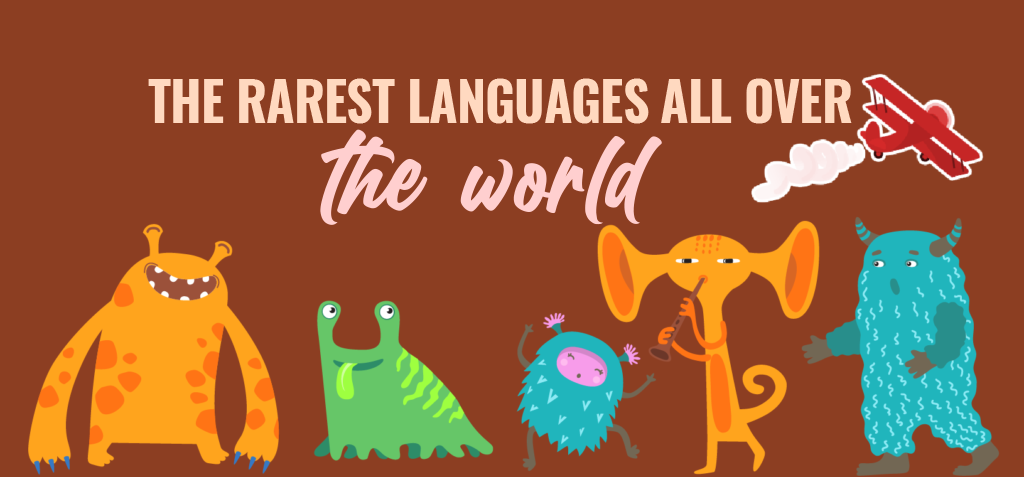The rarest languages in the world

Currently, more than 6,500 languages are spoken around the world, but many of them have very few speakers. In fact, most are disappearing as they become less and less needed in the modern, connected world.
ÍNDICE DE CONTENIDOS
For some of the communities that speak these languages, it is more than just communication. It’s about holding onto your past, your ancestors, and your culture.
Strangest languages all over the globe
It’s a struggle for some though, as the world’s rarest languages are getting rarer all the time.
Pirahã
It is the language spoken by a group of isolated people in Brazil. Today there are about 300 native speakers left. It is the only remaining dialect of the Mura language of the Amazon.
According to the United Nations, every two weeks a language is lost. Language is a necessity for communication, but with more languages on the verge of disappearing, something has to be done. About 6,000 languages are destined to become extinct, due to the loss of native speakers, the integration of other similar languages, and because more people prefer to use the more dominant languages. Everyone’s life is affected by language. Imagine life without it.
Pawnee
Pawnee is a Native American Indian dialect spoken in Nebraska and north-central Oklahoma. Although there are still 10 people who are native Pawnee speakers, they are all older people. Their children prefer to speak English as their native language. Only the elders and chiefs of the Pawnee tribe speak the language fluently. The dialect has nine consonants and eight vowels. It is remarkable that each word in Pawnee has 10 syllables. The pronunciation of the consonants is similar to that of English. Vowels, on the other hand, are more similar to French in pronunciation, with long sounds. Speakers raise or lower their pitch to impart different meanings.
Chamicruo
This language has other similar names. It is spoken in Peru, but currently, there are only half a dozen people who speak it fluently. As all of these people are very old, it seems unlikely that this language will last much longer.
Dumi
Spoken in small areas of Nepal, there were only 8 registered speakers of this language in 2007, many of whom were elderly. Several years later, it is fair to assume that those numbers have fallen further.
Ongota
There are 6 registered speakers of this dying language that is spoken in some parts of Ethiopia.
Liki
Spoken on a few select islands off the Indonesian coast, there were only 5 speakers of this language a few years ago.
Tanema
This language is spoken in the Solomon Islands and used to be much more widespread than it is today, and it is believed that only a handful of people can still speak the language.
Friulan
Most of the speakers are near the Slovenian border with northern Italy. Spoken by the Tuyuca tribe of South America located along the Tiquié, Inambú, and Papurí rivers. Spoken by the Yupik tribe in the Far East of Russia and Alaska
A language that is spoken exclusively in the Archib village and six other smaller villages in the southern part of Dagestan in Russia. The single language has about 1.5 million derivatives for each verb root.
Njerep
Once spoken in Cameroon, there are now only a few speakers of this language and they all live in Nigeria. It has been replaced by a similar language, but with a different dialect.
Chemehuevi
This language is spoken in the United States, although by a very limited number of indigenous people. It has been said that there are only three speakers in total, but the census was conducted a few years ago. They live next to the “kaiv” in Colorado, which is their word for “mountain.”
Lemerig
Spoken on the small island of Vanuatu, there are only two people left who speak this specific dialect of a language that is widespread throughout the region.
Kaixana
This language is spoken in a very small area of South America, and while there were once 200 speakers, now there are only 1.
Taushiro
Also with a single surviving speaker, this language, spoken near the Tigre River, is in its last stages and could soon follow the path of thousands of other endangered languages before it.
Paakantyi
There are various reports on the actual number of active Paakantyi speakers. As a result, there are between 2 and 24 speakers of one of Australia’s Aboriginal languages left. What cannot be denied is the fact that it is also critically endangered. Some schools in Australia are trying to reintroduce the language to the younger generation.
Sarsi
Sarsi or Sarcee, which is spoken by the Tsuu T’ina tribe located in Calgary, Canada, is related to Navajo, the language spoken by the tribe in the southern part of the United States. It is an oral language with no evidence of a writing system. There are also no written records of the language. As of the 2011 census, about 170 still speak the language



